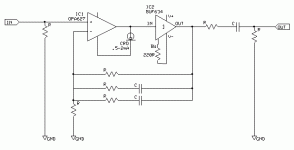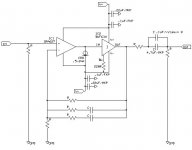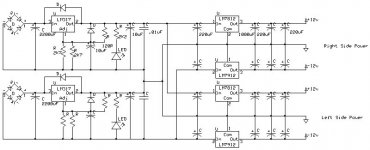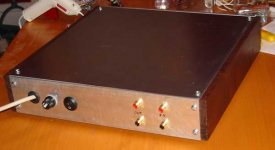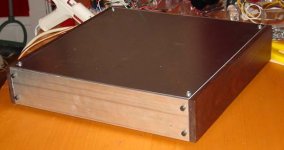Maybe someone else has already preoposed this, but if not, here is the Not So Simple Phono Stage (NSSPS). It is based on the Very Simple Phono Stage (VSPS) but has the addition of a buffer to the opamp which helps drive long cables and, more importantly, allows the opamp to be biased into class A. The buffer on its own did little to the sound (and in fact may have hurt it a little) but biasing the opamp into class A did wonders for me. (The trick is that you need the buffer there for the biasing to work.)
It took this project to the next performance level. One caveat is that you will need to increase the rail caps a bit since the class A nature is drawing more power. I added a second set of 220uF caps to each rail in addition to the 220 suggested in the VSPS. (I also built dual mono power supplies, so with a single supply, that is close to 1000uF per rail.) I also added .33uF film and foil caps very close to the opamp/buffer pins. I could see adding more electrolytics and an extra .1uF to the pins as well as there may not be enough bass for some -- probably depends on your table. For the CRD, I used a monolithic 0.56mA CRD as I had it on hand. I am going to experiment with some larger values as well, but using a jfet pair is also a good way to go.
It took this project to the next performance level. One caveat is that you will need to increase the rail caps a bit since the class A nature is drawing more power. I added a second set of 220uF caps to each rail in addition to the 220 suggested in the VSPS. (I also built dual mono power supplies, so with a single supply, that is close to 1000uF per rail.) I also added .33uF film and foil caps very close to the opamp/buffer pins. I could see adding more electrolytics and an extra .1uF to the pins as well as there may not be enough bass for some -- probably depends on your table. For the CRD, I used a monolithic 0.56mA CRD as I had it on hand. I am going to experiment with some larger values as well, but using a jfet pair is also a good way to go.
Attachments
I would hope that anyone doing RIAA equalization would refer
to Linkwitz's papers on the topic before choosing a feedback/EQ
topology.
As to the location of the feedback, this circuit is just fine as
is. One thing it does for you is relieve the OPA627 of the
burden of driving the falling impedance of the feedback
network as frequency goes up. Driving an RIAA feedback
network is just the thing you don't "want" to do with
most amplifiers. Open loop gain is dropping off with
frequency while load is increasing.
to Linkwitz's papers on the topic before choosing a feedback/EQ
topology.
As to the location of the feedback, this circuit is just fine as
is. One thing it does for you is relieve the OPA627 of the
burden of driving the falling impedance of the feedback
network as frequency goes up. Driving an RIAA feedback
network is just the thing you don't "want" to do with
most amplifiers. Open loop gain is dropping off with
frequency while load is increasing.
Hello everyone
This may not be on topic but I am looking for some suggerstions and help. I want to build a phono stage using opamps. The plan would be to use a socket so I can use different opamps; also to be able to have ample gain for mm cartridges. My budget is somewhat limited, a proven pcb is an option or I could build on a perf board. Any suggestions for a good sounding phono stage would be appreciated and also where I could get the pcb and hard to find parts.
cheers
doggy
This may not be on topic but I am looking for some suggerstions and help. I want to build a phono stage using opamps. The plan would be to use a socket so I can use different opamps; also to be able to have ample gain for mm cartridges. My budget is somewhat limited, a proven pcb is an option or I could build on a perf board. Any suggestions for a good sounding phono stage would be appreciated and also where I could get the pcb and hard to find parts.
cheers
doggy

The VSPS that was the basis of this project can be found here: http://www.geocities.com/rjm003.geo/rjmaudio/diy_pho5.html It is very easy to build and allows some opamp rolling.
Another similar option is the El Cheapo phono: http://www.users.nac.net/markowitzgd/phonopre.html
This project (that the thread is about), to my ear, sounds a bt better than the VSPS, but it does require a few extra parts. Also, while it iworks well with the OPA627, it does not like the AD643 which tends to lock up.
I have attached the schematics and a few pictures.
Another similar option is the El Cheapo phono: http://www.users.nac.net/markowitzgd/phonopre.html
This project (that the thread is about), to my ear, sounds a bt better than the VSPS, but it does require a few extra parts. Also, while it iworks well with the OPA627, it does not like the AD643 which tends to lock up.
I have attached the schematics and a few pictures.
Attachments
I would seriously consider doing the feedback from first opamp only. That removes any cable loading from getting involved. Not to mention, the extra phase shift and instability. Oh, and the overloading of the input on second opamp.
Separate the two functions so they do not interact. Gain and EQ with the first stage. Buffer for the second. Better yet, separate gain and EQ.
jh
Separate the two functions so they do not interact. Gain and EQ with the first stage. Buffer for the second. Better yet, separate gain and EQ.
jh
- Status
- Not open for further replies.
- Home
- Source & Line
- Analogue Source
- The NSSPS (Not So Simple Phono Stage)
